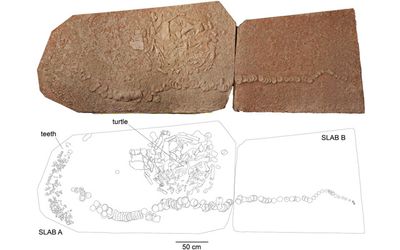An Italian team of paleontologist has studied a Cretaceous fossil shark, more than 7 meters long, belonging to the genus Cretodus. The research was carried out by the Universities of Padova and Ferrara, the CNR-IGG of Padova and the Soprintendenza del Friuli Venezia Giulia in collaboration with the Soprintendenze di Verona and Padova, the Natural History Museum of Verona and Sant'Anna di Alfaedo (VR) Museum.
The only known remains of this genus, that became extinct 80 million years ago, were the teeth discovered in Europe, USA, Africa and Asia. Today, the study published in the Palaeogeography, Palaeoclimatology, Palaeoecology Journal, greatly improved our knowledge on this giant marine predator.
This specimen includes 120 teeth, 86 vertebral centra and many placoid scales. The fossil is the most complete specimen of Cretodus so far discovered.
Strictly connected to the shark skeleton is a pellet-like cluster of partially broken bones belonging to a large chelonioid turtle (estimated total length around 2 m), showing evidence of bites and acid etching damages. Based on these evidences, turtle's remains are interpreted as the stomach content of the shark. This specimen represents the direct evidence of the possible dietary preference of Cretodus. The preservation of some elements of the turtle skeleton, usually easily movable and lost in a rotting carcass, is in favor of predation rather than scavenging.
